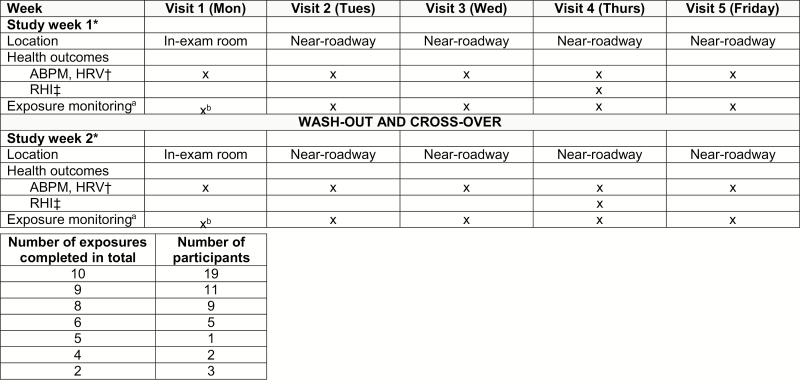Figure 1.
Study protocol flow diagram. The figure is a flow diagram of the randomized single-blind crossover protocol design. The study was conducted during warm months (May to October) 2017–2018 to avoid exposures to excessively cold temperatures. Visits were canceled on case-by-case basis due to inclement weather (excessive cold, storms) at discretion of investigators. Participants were fasting ≥8 hours prior to visits which each lasted 2-hours (8 to 10 am). Participants remained seated in a chair without talking or activity throughout all visits. The near-roadway site was a commuter parking lot (https://www.theride.org/Services/Commuter-Services/Park-Ride/Plymouth-Rd-Park-Ride-Lot) located near to over-pass of Plymouth Road (4-lane roadway) and US-23 (4-lane freeway) in Northeast Ann Arbor, Michigan. The geocode is: 42°18′18.1′′N 83°41′16.7′′W (42.305060, −83.687976). During scripted near-roadway exposures (visits 2–5) participants sat at the south-west corner of the lot within 25 m of south-bound US-23. The study exam room was in the Preventive Cardiology outpatient clinics of Michigan Medicine located at Domino’s Farms Lobby A (<0.5 km from the near-roadway site). aAt the near-roadway exposure site (n = 312), we performed continuous measurements (8–10 am) of fine particulate matter (PM2.5) mass, particle count (PC), black carbon (BC), outdoor ambient temperature and noise intensity (dB). PM2.5 mass and ambient temperature were measured by a personal particulate monitor (Thermo Scientific, pDR-1500). PC was measured by a portable condensation particle counter (TSI, P-TRAK, http://www.tsi.com/p-trak-ultrafine-particle-counter-8525/). Noise intensity (20–140 dB range) was determined by an Optimus sound level meter (OHD, 161B https://afcintl.com/wp-content/uploads/docs/OHD%20pdfs/optimusred.pdf). BC was measured by a micro-aethalometer (MicroAeth, AE51, https://aethlabs.com/). bExposures were measured on several representative days (n = 13) in the exam room due to the stability of parameters and lack of need to repeat monitoring given the indoor clean air patient exam room environment. *Participants were randomized to open-label usage of wearing vs. not-wearing an N95 respirator during all visits (1–5) of each week. For example, if participant #1 did not wear the respirator week 1 then they would crossover to wear it during week 2. We enrolled 2 participants to be exposed concomitantly during each week. Participants were block randomized in the opposite intervention ordering. One participant wore the respirator whereas the other participant undergoing concomitant exposures did not wear it. They would then crossover together to the alternate intervention type. This assured that exposures were nearly identical for the wearing vs. not-wearing the respirator periods. Minor nonsignificant exposure differences occurred due to small unbalances in the enrollment when only one participant missed visits during a study week. Typically, the study was completed over 2 weeks in a row (separated by a weekend washout period). Rarely, there was a 1- to 2-week washout between study weeks for logistical reasons. †ABPM (ambulatory blood pressure monitoring) was performed using the OSCAR-2 with SphygmoCor-inside (Atcor Medical, Sydney; https://atcormedical.com/). The ABPM monitor was positioned on the left upper arm of each participant and measured brachial BP and central aortic hemodynamics from 8 to 10 am every 10-minutes (average of 9 readings per participant each visit). HRV (heart rate variability) metrics were analyzed from continuous electrocardiogram monitoring data using a Spacelabs evo Holter system. Standard deviation of normal-to-normal intervals (SDNN), high frequency (HF), and low (LF) frequency HRV metrics were analyzed using the Pathfinder software system (Spacelabs Healthcare, Snoqualmie, WA). ‡RHI (reactive hyperemia index) was performed using the EndoPAT2000 system (http://www.itamar-medical.com/endopat-main/). Standard protocol was followed per manufacturer directions.

